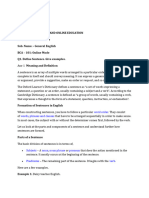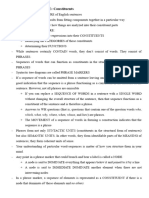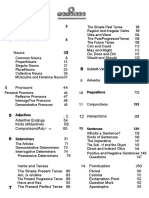0 ratings0% found this document useful (0 votes)
35 viewsSyntactic Categories: Aura Satya Pinasti 1801050043 6B
Syntactic categories are sets of words or phrases that share common characteristics based on structure rather than meaning. The main syntactic categories in English include parts of speech like nouns, verbs, adjectives, and adverbs as well as phrases like noun phrases and verb phrases. Phrase structure refers to the arrangement of sentence elements into larger units by combining constituents from different syntactic categories, such as combining a noun phrase with a verb phrase to form a sentence. The phrase structure can be determined by knowing how English speakers combine each constituent based on its syntactic category.
Uploaded by
Aura SatyaCopyright
© © All Rights Reserved
Available Formats
Download as DOC, PDF, TXT or read online on Scribd
0 ratings0% found this document useful (0 votes)
35 viewsSyntactic Categories: Aura Satya Pinasti 1801050043 6B
Syntactic categories are sets of words or phrases that share common characteristics based on structure rather than meaning. The main syntactic categories in English include parts of speech like nouns, verbs, adjectives, and adverbs as well as phrases like noun phrases and verb phrases. Phrase structure refers to the arrangement of sentence elements into larger units by combining constituents from different syntactic categories, such as combining a noun phrase with a verb phrase to form a sentence. The phrase structure can be determined by knowing how English speakers combine each constituent based on its syntactic category.
Uploaded by
Aura SatyaCopyright
© © All Rights Reserved
Available Formats
Download as DOC, PDF, TXT or read online on Scribd
You are on page 1/ 2
Aura Satya Pinasti
1801050043
6B
Syntactic Categories
1. What is syntactic category?
A syntactic category is a set of words and/or phrases in a language which share a
significant number of common characteristics. The classification is based on similar
structure and sameness of distribution (the structural relationships between these
elements and other items in a larger grammatical structure), and not on meaning. In
generative grammar, a syntactic category is symbolized by a node label in a constituent
structure tree.
2. Please explain the types of syntactic categories in English?
Syntactic categories commonly include: 1. Parts of Speech: (Determiner, Adjective,
Noun, Pronoun, Preposition, Adverb, Auxiliary, Verb), etc; 2. Phrase Structure
Grammars: (Noun Phrase, Adjective Phrase, Verb Phrase, Adverb Phrase, Preposition
Phrase); and 3. Sentence, as the core of the structure.
3. Please explain the words categories in English!
- Verbs
Verbs are action or state words like: run, work, study, be, seem.
- Nouns
Nouns are words for people, places or things like: mother, town, Rome, car, dog.
- Adjectives
Adjectives are words that describe nouns, like: kind, clever, expensive.
- Adverbs
Adverbs are words that modify verbs, adjectives or other adverbs, like: quickly, back,
ever, badly, away generally, completely.
- Prepositions
Prepositions are words usually in front of a noun or pronoun and expressing a
relation to another word or element, like: after, down, near, of, plus, round, to.
- Pronouns
Pronouns are words that take the place of nouns, like: me, you, his, it, this, that,
mine, yours, who, what.
- Conjuctions
A conjunction (also called a connective) is a word such as and, because, but, for, if,
or, and when. Conjunctions are used to connect phrases, clauses, and sentences.The
two main kinds are known as coordinating conjunctions and subordinating
conjunctions.
- Determiner
A determiner is a word that introduces a noun, such as a/an, the, every, this, those,
or many (as in a dog, the dog, this dog, those dogs, every dog, many dogs).
The determiner the is sometimes known as the definite article and the determiner a
(or an) as the indefinite article.
- Interjections
An exclamation (also called an interjection) is a word or phrase that expresses strong
emotion, such as surprise, pleasure, or anger. Exclamations often stand on their
own, and in writing they are usually followed by an exclamation mark rather than a
full stop. Interjections have no grammatical value - words like: ah, hey, oh, ouch, um,
well.
4. What is a phrase structure?
Phrase structure comes from the root word structure. Phrase structure has meaning in
the field of linguistics. Arrangement of sentence elements to form larger units, for
example nominal phrases plus verbal phrases to form sentences.
5. How to determine a phrase structure?
To determine a phrase structure, we as English speakers know how to combine each
constituent from its syntactic category. For example, 1) the sentence "sentence" (S) can
be formed from a noun (NP) and a verb phrase (VP) as in example (1) below. 2) The
noun phrase (NP) can possibly be formed from a determiner (Det) and a noun (N), as in
example (2) below. 3) Verb phrases that contain a transitive verb (VT) followed by an
object. direct noun phrase ("direct object").
You might also like
- Syntax: Chương Trình Đào Tạo Trực TuyếnNo ratings yetSyntax: Chương Trình Đào Tạo Trực Tuyến36 pages
- Syntax: - Definition of Syntax - Noun Phrase and Verb Phrase - Phrase Structure Rules/ Tree DiagramsNo ratings yetSyntax: - Definition of Syntax - Noun Phrase and Verb Phrase - Phrase Structure Rules/ Tree Diagrams20 pages
- Syntax: The Relationship Between Morphology and Syntax100% (1)Syntax: The Relationship Between Morphology and Syntax13 pages
- Engl 412 Advanced descriptions of Modern English.No ratings yetEngl 412 Advanced descriptions of Modern English.45 pages
- Comprehensive English Grammar Guide: From Basics to Competitive ExcellenceFrom EverandComprehensive English Grammar Guide: From Basics to Competitive ExcellenceNo ratings yet
- Group Members: Roslina Kamaldin 1102499 Azinah Abd Aziz 1102505 Norsham Nasir 1102489No ratings yetGroup Members: Roslina Kamaldin 1102499 Azinah Abd Aziz 1102505 Norsham Nasir 110248918 pages
- Syntax: The Analysis of Sentence StructureNo ratings yetSyntax: The Analysis of Sentence Structure44 pages
- Grammatical Units: They Are Meaningful and Combine With Each Other in Systematic WaysNo ratings yetGrammatical Units: They Are Meaningful and Combine With Each Other in Systematic Ways8 pages
- Syntax: Though), and Interjections (Oh, Phew) - Modern Linguists, Though AcceptNo ratings yetSyntax: Though), and Interjections (Oh, Phew) - Modern Linguists, Though Accept4 pages
- Kesalahan Siswa Dalam Menerjemahkan Materi Bacaan Bahasa Arab Ke Dalam Bahasa Indonesia Muzia Ranselengo, Mukhtar I MioloNo ratings yetKesalahan Siswa Dalam Menerjemahkan Materi Bacaan Bahasa Arab Ke Dalam Bahasa Indonesia Muzia Ranselengo, Mukhtar I Miolo10 pages
- Bullying and Its Impact On Someone's Life: By: Aura Satya Pinasti (1801050043) Silfi Febritha (1801050056)100% (1)Bullying and Its Impact On Someone's Life: By: Aura Satya Pinasti (1801050043) Silfi Febritha (1801050056)22 pages
- The Use of Instagram As A Learning Media To Improve Students VocabularyNo ratings yetThe Use of Instagram As A Learning Media To Improve Students Vocabulary8 pages
- English Lic. Norma Isabel Portilla Mánica 11 TeamNo ratings yetEnglish Lic. Norma Isabel Portilla Mánica 11 Team6 pages
- French Guidelines For Transcriptions and SubtitlesNo ratings yetFrench Guidelines For Transcriptions and Subtitles27 pages
- 8 Types of Interjection in English GrammarNo ratings yet8 Types of Interjection in English Grammar6 pages
- Performance Standards For The CELPIP Speaking100% (1)Performance Standards For The CELPIP Speaking2 pages
- CBLM Participate in Workplace Comm. NC IiNo ratings yetCBLM Participate in Workplace Comm. NC Ii101 pages
- Interjection in English Grammar With Examples PDF100% (2)Interjection in English Grammar With Examples PDF3 pages
- Stylistic Analysis of Clean Well-Lighted Place100% (2)Stylistic Analysis of Clean Well-Lighted Place18 pages



































































































